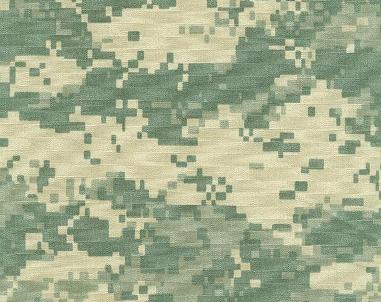War is a lucrative business, which also means that mistakes can be costly. One of the priciest screw-ups in recent military history comes from the US army, which reportedly wasted heaps of dollars developing a stylish-looking new camouflage, only to discover it didn’t effectively hide their soldiers.
The Universal Camouflage Pattern (UCP) was designed in 2004, taking “inspiration” from the pixelated pattern from the computer-generated camouflage of the Canadian Armed Forces (called CADPAT).
Using grey, beige, and green square pixels, the idea was that the pattern hid people in all warfare environments, whether it be urban streets, forests, or deserts. Since the US was currently at war with Iraq and Afghanistan, it was especially important that it concealed soldiers in harsh, arid environments.
Unfortunately, it didn’t. While the digital camo excelled through lab tests and selection processes, there’s no evidence that the UCP had ever undergone field testing before it was rolled out in 2004/2005.
US soldiers serving in Iraq and Afghanistan quickly started to question the effectiveness of the UCP, arguing that the new camouflage was actually making them stand out against their enemies.

It turned out, the design failed to consider an optical effect known as “isoluminance”.
If human eyes are shown visual stimuli from a distance that have sharp variations in colour without any contrasts in lightness – such as a pixelated pattern made of just three different colors – then we tend to just perceive the patterns as a single mass. In other words, from a distance, the pixels just blurred into a single blob that stuck out against the surrounding environment.
As the War in Afghanistan stumbled along, criticism towards UCP mounted. In 2012, a government watchdog reportedly issued “a scathing report” against the pixel camo, arguing it put troops at risk and had potentially wasted $5 billion of taxpayers’ money.
By 2014, the US Army announced it was discontinuing the UCP, replacing it with the new Operational Camouflage Pattern by the end of September 2019. Unlike the UCP, the updated Operational Camouflage Pattern was part of a “family” of camouflage with different color palettes, including a dark variant for jungle-woodland environments and a lighter pattern for arid climates.
The moral of the story: the digital-print camo might have looked slick, but its promise of being a “universal” uniform was overstretched.
This wasn’t the only costly uniform blunder that occurred during the years of the Afghanistan War, however. As part of their effort to train up Afghanistan’s security forces after invading the country, the US reportedly overspent $28 million on the new uniforms of the Afghan National Army.
The reason for the waste of money was that the Afghan minister of defense, Abdul Rahim Wardak, picked a forested camouflage without acknowledging that Afghanistan is pretty damn dry.
“They picked the pattern based on a fashion preference, not by experts,” said John F Sopko, the Special Inspector General for Afghanistan Reconstruction
“That was a dumb decision.”
Source Link: The US Army Once Spent Billions On Pixel Camouflage That Didn't Work